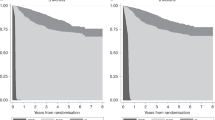Abstract
Background: Two randomised, controlled trials (n = 1396) comparing (i) intravenous fluorouracil (FU) plus oral folinic acid (leucovorin) and (ii) oral tegafur plus uracil (UFT) plus folinic acid for the treatment of metastatic colorectal carcinoma found both regimens to have equivalent efficacy in terms of survival, tumour response and time to disease progression. The UFT/folinic acid regimen was associated with a better toxicity profile than FU/folinic acid.
Objective: To determine the comparative frequencies and costs of healthcare resources utilised in the treatment of patients with these two regimens from a hospital and government perspective.
Design: A cost-minimisation analysis of a subgroup of patients from the trials (n = 154) was conducted. Costs considered included those for hospital admissions, outpatient clinics, laboratories, imaging modalities, other diagnostic procedures, physician resources, other health professionals, other procedures such as surgery and transfusion, and concomitant medications. The cost of study medications was not included in the analysis. The endpoint was a total average cost per patient per treatment and per cycle.
Results: Patients on the oral UFT regimen had fewer outpatient clinic visits and used fewer laboratory resources than patients treated with FU. However, those on the oral regimen had more days of hospitalisation than the patients treated with the intravenous regimen. Patients treated with UFT used 21% less concomitant medication; however, in both groups these medications accounted for a similar percentage compared with the total costs of the treatment. Physicians’ fees were similar for both groups but patients treated with UFT were seen more often by an attending physician. Patients on the UFT regimen visited outpatient oncology clinics less often and this was reflected by a maximum 826 Canadian dollars ($Can; 1996 values) total cost savings per patient per cycle and $Can3221 per patient per treatment. An efficiency analysis showed that the use of the UFT/folinic acid regimen saved 4.5 hours per patient per month in the chemotherapy treatment unit compared with the FU regimen.
Conclusions: In regard to the two therapeutic approaches, the cost of treatment per patient and per cycle using oral UFT/folinic acid was less than that using intravenous FU/folinic acid.









Similar content being viewed by others
References
Health Canada. National Cancer Institute of Canada. Canadian cancer statistics 1999. Toronto: Health Canada, 1999
Poon MA, O’Connell MJ, Moertel CG, et al. Biochemical modulation of fluorouracil: evidence of significant improvement of survival and quality of life in patients with advanced colorectal carcinoma. J Clin Oncol 1989; 10: 1407–18
Tagushi T. Experience with UFT in Japan. Oncology 1997; 11 Suppl. 10: 30–4
Douillard J-Y, Hoff PM, Skillings JR, et al. Multicenter phase III study of uracil/tegafur and oral leucovorin versus fluorouracil and leucovorin in patients with previously untreated metastatic colorectal cancer. J Clin Oncol 2002; 20 (17): 3605–16
Carmichael J, Popiela T, Radstone D, et al. Randomized comparative study of tegafur/uracil and oral leucovorin versus parenteral fluorouracil and leucovorin in patients with previously untreated metastatic colorectal cancer. J Clin Oncol 2002; 20 (17): 3617–27
Canadian Coordinating Office for Health Technology Assessments (CCOTHA). Guidelines for the management information system in Canadian healthcare facilities (MIS guidelines). Ottawa (ON): Canadian Coordinating Office for Health Technology Assessments (CCOTHA), 1997
Canadian Coordinating Office for Health Technology Assessments (CCOTHA). A guidance document for the costing process. Ottawa (ON): Canadian Coordinating Office for Health Technology Assessments (CCOTHA), 1996
Acknowledgements
The authors would like to acknowledge Mr Bruce Wilson and Johanne Pelletier for assistance in the preparation of the manuscript. This study was supported by Bristol-Myers Squibb Canada.
Author information
Authors and Affiliations
Corresponding author
Appendices
Appendix: Patient Inclusion and Exclusion Criteria
Inclusion Criteria
The inclusion criteria were as follows:
• Histologically confirmed metastatic colorectal carcinoma unsuitable for definitive surgical resection.
• Evaluable or measurable disease.
• Any prior colorectal adjuvant treatment must have been completed at least 6 months prior to study enrolment. Adjuvant therapy may have been given before and/or after surgery. This includes any modality (e.g. chemotherapy, radiation, immunotherapy).
• At least 4 weeks post major surgery and fully recovered.
• Eastern European Cooperative Oncology Group (ECOG) performance status ≤2.
• Signed informed consent form indicating awareness of the investigational nature of the study.
• Aged 18 years or older.
• Adequate bone marrow function as defined by a peripheral absolute granulocyte count of ≥2000 cells/mm3.
• Adequate liver and renal function as defined by bilirubin and creatinine levels within each institution’s upper normal limits.
• Negative pregnancy test for fertile women.
• Adequate contraception for women of childbearing potential.
Exclusion Criteria
Exclusion criteria were as follows:
• Any prior treatment (e.g. radiation therapy, chemotherapy or immunotherapy) or metastatic colorectal carcinoma.
• Lack of contraception in women of childbearing potential.
• Pregnancy or lactation.
• Concurrent serious infections. All patients must have been afebrile (<37.5°C) at start of therapy unless fever was due to tumour.
• Inability to obtain informed consent because of psychiatric problems or complicating medical problems.
• Oncological emergency (e.g. superior vena cava [SVC] syndrome, spinal cord compression).
• History of prior malignant neoplasms. Patients who had had adequate treatment for basal cell or squamous cell skin cancer, or in situ carcinoma of the cervix at any time were eligible.
Rights and permissions
About this article
Cite this article
Maroun, J.A., Asche, C., Romeyer, F. et al. A cost comparison of oral tegafur plus uracil/folinic acid and parenteral fluorouracil for colorectal cancer in Canada. Pharmacoeconomic 21, 1039–1051 (2003). https://doi.org/10.2165/00019053-200321140-00004
Published:
Issue Date:
DOI: https://doi.org/10.2165/00019053-200321140-00004




